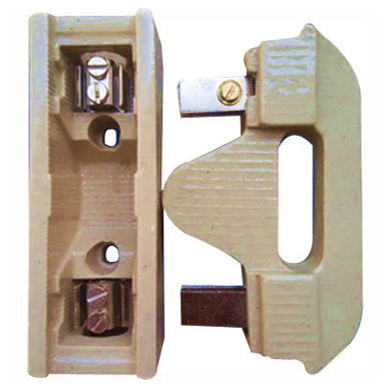In this topic, you study Semi Enclosed Fuse or Rewirable Fuse or Kit Kat fuse – Theory, Construction & Diagram.
In this type of fuses, the fuse element is semi-enclosed i.e. neither open nor totally closed. They are available in various forms. Fig. 1 illustrates a typical rewirable fuse bridge and base (also known as a kit-kat type fuse unit).

Fig. 1: Rewirable fuse bridge and base
The fuse element (E) consists of a short length of fuse wire of diameter depending upon the current rating of the circuit the fuse is protecting. The wire is threaded through a small hole in the porcelain fuse bridge (B1) and secured to the contacts (C) by means of screws (S). The incoming and outgoing live or phase wires are connected permanently with the help of connecting terminals to the base (B2). These terminals of the base are bridged by the contacts of the bridge through the fuse element when the bridge fits into the base. A pictorial view of the Kit Kat Fuse is shown in Figure 2.

Fig. 2: Kit Kat Fuse
Operation of Kit Kat Fuse
The fuse is wired in series with the circuit to be protected. At the fuse, because of the highest resistance, more heat is developed than at any other point in the circuit. During the fault, the circuit current rises in value. Therefore, the heat produced at the fuse causes temperature of the fuse wire to rise to a value high enough to melt the wire and thus break the circuit.
Application of Kit Kat Fuse
Commonly used in domestic installations and the other circuits where very low values of fault currents are to be handled.
Advantages of Kit Kat Fuse
- They are cheaper.
- After blowing Off the fuse element, the bridge can be pulled out and again rewired with a new fuse wire. Thus, service can be restored very quickly with negligible additional expenditure.
Disadvantages of Kit Kat Fuse
- Cannot be used for higher values of fault current.
- Protection is not reliable due to inaccurate characteristics.
- Since the wire is exposed to air, it is subjected to deterioration due to oxidation caused by heating. This decreases the effective diameter Of the wire. Heating due to increased resistance causes premature failure under normal load.
- Slow speed i.e. current interruption is not quick in comparison with other interrupting devices.
- Risk of fire hazards due to external flash on blowing.